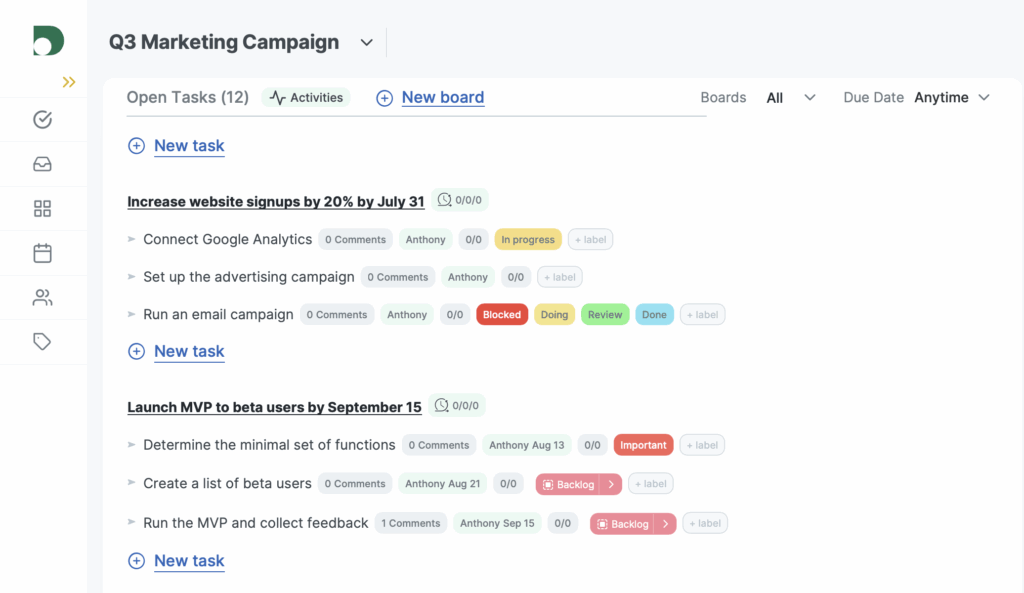
In our hyper-connected world, staying organized and on top of tasks can feel like a full-time job. Whether you’re a freelancer, student, or professional juggling multiple responsibilities, finding the right way to manage your time is essential. That’s where personal productivity apps come into play. These tools act like digital assistants – helping you plan, prioritize, and accomplish your goals with less stress.
But how effective are they, really? And what should you look for in a productivity tool?
Let’s take a look at the key features of effective personal productivity apps and how the right tool can help transform your daily workflow.
Why Use Personal Productivity Apps?
Productivity apps aren’t about doing more – they’re about doing what matters better.
The best apps help you:
- Capture your to-dos in a clear and structured way
- Prioritize what’s most important
- Stay accountable to yourself (and to others)
- Track progress over time
- Reduce mental clutter
A great productivity app becomes your go-to space for organizing thoughts, planning your week, and checking things off your list – without the chaos of sticky notes and scattered documents.
Must-Have Features in a Personal Productivity App
Let’s explore the core features that make a productivity app truly helpful for personal use.
1. Task Organization with Boards and Lists
A strong productivity app allows you to organize tasks within boards, making it easy to separate different areas of your life or projects (e.g., Work Projects, Personal Goals, Learning, etc.).
Within each board, you can create tasks and arrange them into boards – allowing for custom organization like “Ideas”, “To Do”, “In Progress”, and “Done”.
This structure provides flexibility without complexity, and gives you a clean overview of what you’re working on.

2. Subtasks and Checklists
Not all tasks are created equal – some have multiple steps. That’s why checklists and subtasks are essential.
Instead of creating a dozen separate tasks, you can break down one larger task into actionable items. Whether you’re planning a blog post, launching a campaign, or organizing a trip, having all the steps in one place helps keep your focus sharp.

3. Recurring Tasks
Many tasks repeat on a regular basis – weekly reports, daily habits, monthly planning sessions. With recurring task options, you only need to set it once, and it will automatically appear at the right time in the future.
No need to retype or remember; your productivity tool does the remembering for you.
4. Task Comments and Reactions
Communication is part of productivity – even when it’s just with your future self.
Look for features like comments and emoji reactions within each task. This helps you keep notes, updates, and decisions attached to the task itself. You can mark progress, jot reminders, or leave feedback for teammates if you’re collaborating.

If you are curious about what are numbers doing among emoji – these are story points, you can learn about them in our post.
5. Email Notifications
Staying on track sometimes requires a gentle nudge.
Personal productivity apps with email notification settings ensure you never forget what’s due. You can get reminders when tasks are assigned, due soon, or updated – keeping your day moving without needing to check the app constantly.

6. Custom Tags for Better Sorting
Tags make it easy to label and group tasks based on priority, topic, or status. For instance, you can tag tasks as Urgent, Long-Term, or Waiting on Someone.
Then, when you want to focus on a specific kind of task, just filter by tag – and boom, you’ve got a clear, distraction-free list.

7. Progress Overview for Boards
Ever reach the end of the week and wonder, “What did I actually finish?”
With a board-level progress tracker, you can get a visual summary of how much work is completed vs. what’s left. This gives you a sense of momentum and helps identify areas that might need extra attention.
Getting started with a personal productivity apps
You don’t need to be a productivity guru to start using these tools effectively. Here’s a simple setup to try:
- Create a few boards (e.g., Personal, Work, Health)
- Add tasks and break them down into checklists
- Assign due dates and tags to keep things clear
- Enable notifications to get reminders
- Review your progress at the end of each week
Give it a week, and see how much clearer your day becomes!
doBoard: simple app, big impact
Personal productivity apps are more than digital to-do lists – they’re systems that help you reduce stress, organize your time, and feel accomplished at the end of the day.
The key isn’t to do more – it’s to do what matters with clarity and consistency. Whether you’re managing your daily tasks or planning long-term goals, a solid app can make your life smoother and your work more meaningful.
Try your 45-day free trial today and watch your productivity take off.
- Personal Productivity Apps – How Effective They Really Are? - July 20, 2025
- How Does Procrastination Affect Your Time Management? And How to Beat It - July 20, 2025
- Major doBoard updates – July 2025 - July 18, 2025